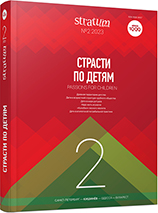Колесный транспорт в петроглифах горы Усо в Армении: отражение реальных и мифологических представлений
Wheel Transport in Petroglyphs of Huso Mountain in Armenia: a Reflection of Realistic and Mythological Views
Author(s): Vitalii V. StepkinSubject(s): History, Archaeology, Ancient World, Prehistory
Published by: Издательский дом Stratum, Университет «Высшая антропологическая школа»
Keywords: petroglyphs of Huso mountain; rock art of Armenia; wheel transport of the Bronze Era; carts; cosmogonic myths of Rigveda; Aryan tribes; Indra; Vritra; Pushan; Surya in Vedic mythology;
Summary/Abstract: The paper is aimed to examine petroglyphs depicting wheel transport on stones of Huso mountain in Armenia. The research objectives are to define design features of wheel transport, to determine its cultural and chronological background, to consider the semantics of these images. Semiotic analysis of historical content and analogy was used to cope with the task. Results. The first petroglyph presents a two-wheeled horsed carriage. The wheel transport cut on two other stones is depicted as an element of compositions. The first composition includes the following signs: a two-horse carriage (biga), two anthropomorphous forms, a chaotically twisting snake (a sign of anrta — chaos), two coiled snakes (a sign of rta — cosmic order). The second composition pictures a three-horse carriage (triga), an anthropomorphous form with a tool in hands, a bezoar goat (lat. Capra hircus aegagrus). The described petroglyphs with carriages are dated by the author by the methods of historical content and analogues from 2nd millennium B.C. They contain mythological subjects connected with cosmogonic views reflected in Rigveda. The petroglyphic compositions accompanied some certain cult actions directed to advance the cattle-raising cycle coinciding with the summer solstice. As Aryans understood, by the beginning of each seasonal movement of nomadic tribes in the alpine zone, the charioteer Indra, following the cosmogonic plot, defeated the daemon Vritra who had turned water streams of Mt. Huso into snow and ice. Conclusion. The wheel transport petroglyphs on Mt. Huso stones are an important source for study.
Journal: Stratum plus. Археология и культурная антропология
- Issue Year: 2023
- Issue No: 2
- Page Range: 169-182
- Page Count: 14
- Language: Russian
- Content File-PDF

